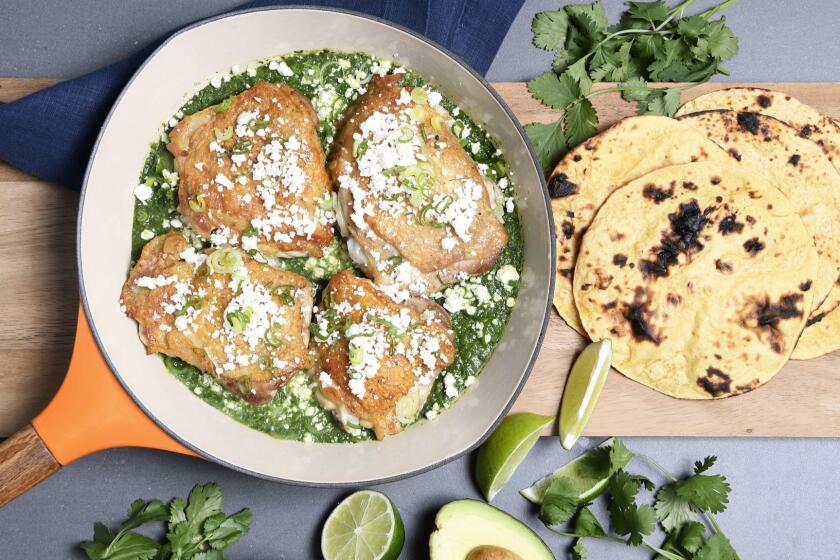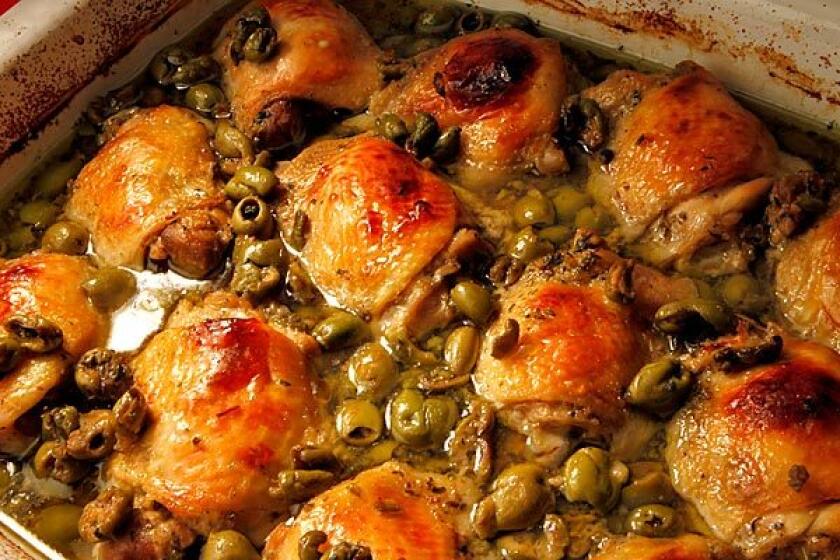As dark-meat chicken’s popularity grows, breeders aim for smaller breasts

- Share via
These are dark days for white meat.
For decades, the chicken breast has been America’s darling. Now everybody, it seems, is doubling down on thighs.
In the United States, production is at a record high. Retail sales of thighs have jumped ninefold in the last decade, and restaurants are buying more dark meat too, according to Tyson Foods Inc., the largest U.S. meat processor.
“Consumers’ palates are changing,” said Sabrina Bewley, Tyson’s senior director of foodservice poultry marketing and innovation. “They seek out more Latin, Indian and East Asian dishes, which often feature dark meat.”
The fate of chicken breasts can be blamed partly on the poultry industry, which created birds so big-chested that some developed a tough, coarse texture that’s come to be known as “woody breast.” Sanderson Farms Inc., the third-biggest U.S. chicken producer, said it’s testing the creation of birds with smaller breasts, and Chief Executive Joe Sanderson said breeding birds with more dark meat makes “all the sense in the world.”
Over the next year, the company will be deboning dark meat in all seven of its plants that process large birds, said President and Chief Operating Officer Lampkin Butts. That’s up from just one or two plants two years ago, he said.
Automation favors dark meat. Robots are better than people at processing dark meat, while a human touch is still needed to get the best yields from breast meat, Butts said. Tight labor conditions are plaguing the meat industry.
The Santa Monica farmers market was one of my first destinations after moving to L.A. a few months ago; I went to feel some connectivity to my new home after weeks of moving limbo.
Demand is so high for thighs that prices have eclipsed that of the traditionally more expensive breasts. As of July 10, jumbo boneless, skinless chicken breasts were $1.13 a pound, and the equivalent boneless, skinless thighs were $1.24, according to Russ Whitman, senior vice president at commodity researcher Urner Barry.
It’s a reversal of white meat’s decades-long U.S. market domination. Dark meat has always been more popular abroad, but breasts became the big thing in the United States in the 1980s when producers started cutting up birds for the sake of convenience. Before that, consumers bought whole birds, and it was up to home cooks to do the dismembering. White meat caught on because it was lower in fat and perceived to be healthier, while the dark meat was often added to sausage or shipped to countries such as Russia.
“Just because of the fat content and wholesomeness of the breast, people really flocked to that,” National Chicken Council spokesman Tom Super said. “Pun intended.”
Today’s U.S. diners aren’t so afraid of fat or of a more global cuisine. Chipotle Mexican Grill Inc. bought more than 115 million pounds of chicken last year, 600,000 pounds more than it used in 2016 — all of it dark meat.
Frozen-food maker Saffron Road is using dark meat in more entrees, including a Thai green curry and meatballs. The dark meat helps form a tasty gravy, and it’s more nutritionally dense, said John Umlauf, the company’s senior vice president of culinary operations.
“The dark meat has more blood in it,” he said. “That’s why it’s juicier. White meat can dry out.”
Salad chain Sweetgreen has added blackened chicken thighs to its offerings. Panera Bread’s new dinner menu contains items made only with chicken thighs for the first time. And the TGI Fridays test kitchen is working on a sweet-and-sour tempura dish featuring thighs after replacing 25% of the white meat in chicken quesadillas with dark.
Chicken thighs with honey, olives and oregano Total time: About 2 hours, plus marinating time Servings: 6 Note: Adapted from “The Essential Book of Jewish Festival Cooking” by Phyllis Glazer and Miriyam Glazer.
Bell & Evans plans to introduce meatballs made without breast meat. The company is also investing $5 million in new leg deboning equipment to make the meatballs for supermarkets, along with a breaded thigh “that’s juicier and more flavorful than a breaded breast,” owner Scott Sechler said. “The breaded thigh makes an amazing sandwich, and we predict it will soon replace traditional breaded breasts in a lot of popular chicken sandwiches.”
At Perdue Foods, the fourth-biggest U.S. poultry producer, thigh sales increased 7% in the year that ended June 16, while breast-meat sales were flat, according to Chief Marketing Officer Eric Christianson.
Historically, thighs were more attractive to frugal shoppers. Now it’s the taste and the ease of preparation.
“It’s a better eating experience,” Christianson said. “It’s very difficult to mess up a thigh.”
More to Read
Inside the business of entertainment
The Wide Shot brings you news, analysis and insights on everything from streaming wars to production — and what it all means for the future.
You may occasionally receive promotional content from the Los Angeles Times.












